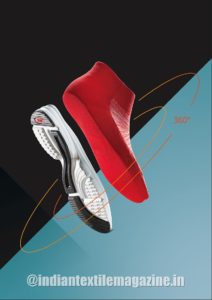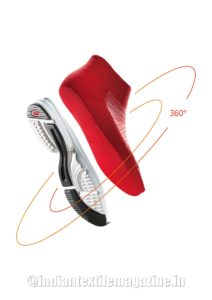With the potential to automate production, reduce labor and inventory costs, and localize production, 3D knitting is changing the way shoes are made.
In recent years, consumer preferences have quickly swayed towards knitted shoe uppers due to two different, yet related phenomena. First, as environmental consciousness penetrates societies around the world, demand for leather shoes is also declining considerably, resulting in a subsequent increase in demand for textile-based shoes. Second, an acute cultural shift towards athleticism and wellness has manifested itself in rising demand for athletic footwear. In response, manufacturers began focusing even more heavily on knitted shoe upper production.
In 2012, Nike and Adidas both launched a line of virtually seamless, knitted shoes, and were met with incredible success. Not only does the seamless design provide an almost “second-skin” feel, but removing cutting from the production process has significantly cut down on waste – 60% in the case of the Nike FlyKnit – while simultaneously reducing labor hours and environmental impact, improving inventory management, accelerating to market time, and allowing for ultimate customization.
However, there are still distinct limitations to the current seamless knitting technology. First, while the process is markedly less labor intensive than the traditional cut-and-sew methods, it is not yet fully automated. In search of a more perfect solution, shoe upper manufacturers are looking to 3D knitting, which promises to all but eliminate human labor from the production process and break through the seamless knitted shoe bottleneck.
Fully automated production
At present, a factory with 100 flat knitting machines will need at least 200 people to handle subsequent finishing work, because current production processes continue to rely on labor-intensive cutting and sewing steps. As such, labor costs for global shoe manufacturers remain stubbornly high.
While the seamless knitting production method demonstrated by Nike and Adidas has eliminated cutting from the post-production process, significantly reducing labor, it is not yet fully automated. After a seamless shoe upper is knitted, each shoe upper still needs to be individually heat-set and then sewn to the insole. This labor-intensive post-production process presents a considerable obstacle towards further developing seamless shoe upper manufacturing.
3D seamless knitting technology may be exactly what the industry needs to solve this problem. This new technology enables flat knitting machines to produce a complete shoe upper, ready to be directly connected to the sole, with a single machine. This leap in knitting technology presents an exciting possibility of completely eliminating labor-dependent cutting, sewing and heat-setting from the shoe production process – and fully automating shoe upper manufacturing.
Raw materials also represent a considerable expense in the shoe manufacturing process, which is only aggravated by extreme fabric waste. Warp knitting machines, for example, waste around 20-25% of fabric during production (an equivalent of approximately 132.6 tons per million pairs). Using 3D knitting solutions, each upper is completed individually and requires no cutting or sewing post-production, resulting in a completely seamless shoe upper — and reducing waste by as much as 60%, in the case of the Nike FlyKnit.
Furthermore, replacing leather with textiles has a positive impact on the environment. While leather shoes only account for a quarter of overall footwear production, they are responsible for an estimated 30-80% of global impacts on all metrics, including climate change, resource use and freshwater withdrawal. This is in stark contrast to textile shoes, which only represent 6-21% of total impact in the same categories.
Faster to market time
Matt Powell, a well-known sneaker expert and Vice President of the market-research firm NPD, believes traditional marketing and distribution plans are unable to keep pace with modern consumer preferences. In an interview with Quartz, he noted that the average concept-to-market time is approximately 18 months if everything goes smoothly (which it rarely does). At the same time, fashion cycles are compressing. He provides the notable example of performance basketball shoes, which began to catch on in early 2012 and died by mid-2015.
If the lifecycle of modern trends has been compressed to just 3.5 years, the concept-to-market process will need to be adjusted accordingly. The Adidas Speedfactory is one attempt to close this gap. By bringing production closer to consumers, Adidas has managed to accelerate to market time by a factor of 3. In the future, Adidas hopes their Speedfactory will be able to complement their original production lines by quickly producing limited runs of customized products, or replenishing certain products that are selling more quickly than expected. 3D knitting opens the possibility of streamlining concept-to-market time by implementing a realistic local production solution.
On an average, inventory costs generally represent 20-30% of the total inventory value. Even the most accomplished inventory managers are unable to bring inventory costs down to zero, partly because it’s so difficult to accurately predict how well or poorly a certain item will sell. Overstocking unpopular items is a big source of loss for many retailers, and is a pain point many are looking to resolve.
3D knitting offers a solution to the inventory problem. Rather than estimate consumer demand months ahead of time – and risk losses due to unsold inventory – 3D knitting opens the possibility to manufacture locally according to real-time demand. While this particular solution is still in its infancy, there is plenty of potential for 3D knitting to begin developing in this direction.
As professional service companies Deloitte, McKinsey and Company, and PWC all indicate global consumers are demanding more personalization. As such, manufacturers the world over are finding ways to deliver customized products, which has led to new sales models such as PAM, speed factory, and in-house production – all of which emphasize local production and faster distribution.
This is one of the major advantages of 3D knitting. Because 3D knitting solution offers a local production option, customers can order customized shoes and have them delivered within a few days, cutting down manufacturing and distribution time from several months to just a few days. The Adidas Speedfactory is beginning to realize this concept on a smaller scale; in the future, they are hoping to equip each retail store with a 3D knitting machine so customers can take their foot measurements and order customized shoes in store.
The future of 3D knitting
Although the entire shoe manufacturing industry is marching towards 3D knitting solutions, they still have a long way to go before they develop a comprehensive solution. For a 3D knitting solution to truly become practical, it needs to be able to knit a double-sided upper while maintaining the versatility and flexibility of shoe uppers.
The seamless shoe uppers that are in existence today have been manufactured using a slightly improved sock machine, producing an end product that is much too thin, ‘tongue-less’, and rather limited in terms of design possibilities. As such, current technologies still require a certain amount of processing post-production. There is still a lot of room for improvement, but it’s certainly an exciting industry to watch.
Pailung products and solutions
Pailung, an internationally renowned knitting machinery company, is one of the first brands in the world to launch a 3D seamless knitting technology that can truly meet industry’s growing need for a fully automated shoe production line. They are one of the only companies that currently provides a full 3D knitting solution that can knit the entire shoe structure, ready to be attached to the sole.
Their ShupperKnit featuring 3D knitting solution is quite straightforward. The operator can easily load the desired parameters into the program, after which a single, seamless shoe upper, including the insole, with be produced immediately in a process that is as seamless as the shoes themselves.

